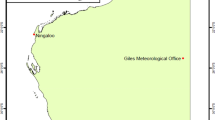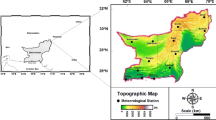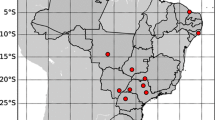Abstract
In this paper, we have utilized ANN (artificial neural network) modeling for the prediction of monthly rainfall in Mashhad synoptic station which is located in Iran. To achieve this black-box model, we have used monthly rainfall data from 1953 to 2003 for this synoptic station. First, the Hurst rescaled range statistical (R/S) analysis is used to evaluate the predictability of the collected data. Then, to extract the rainfall dynamic of this station using ANN modeling, a three-layer feed-forward perceptron network with back propagation algorithm is utilized. Using this ANN structure as a black-box model, we have realized the complex dynamics of rainfall through the past information of the system. The approach employs the gradient decent algorithm to train the network. Trying different parameters, two structures, M531 and M741, have been selected which give the best estimation performance. The performance statistical analysis of the obtained models shows with the best tuning of the developed monthly prediction model the correlation coefficient (R), root mean square error (RMSE), and mean absolute error (MAE) are 0.93, 0.99, and 6.02 mm, respectively, which confirms the effectiveness of the developed models.









Similar content being viewed by others
References
Acharya N, Shrivastava NA, Panigrahi BK, Mohanty UC (2013) Development of an artificial neural network based multi-model ensemble to estimate the northeast monsoon rainfall over south peninsular India: an application of extreme learning machine. Clim Dyn 43(5):1303–1310
Afshin S, Fahmi H, Alizadeh A, Sedghi H, Kaveh F (2011) Long term rainfall forecasting by integrated artificial neural network-fuzzy logic-wavelet model in Karoon basin. Sci Res Essays 6(6):1200–1208
Gammel BM (1998) Hurst’s rescaled range statistical analysis for pseudo random number generators used in physical simulations. The American physical society. Journal 58(2):2586–2597
Govinda K, Hiremath S (2014) Rainfall prediction using neural networks. Int J Appl Eng Res 9(23):21243–21254
Haltiner GJ, Williams RT (1980) Numerical prediction and dynamic meteorology, 2nd edn. Wiley Press, New York
Heydari M (1996) Meteorological forecasting (classical and numerical methods) scientific and technical. Journal of meteorological organization of Iran (Nivar) 30:61–66
Hung NQ, Babel MS, Weesakul S, Tripathi NK (2009) An artificial neural network model for rainfall forecasting in Bangkok, Thailand. Hydrol Earth Syst Sci 5:183–218
Hurst HE (1951) Long term storage capacity of reservoirs. Trans Am Soc Eng 116:770–799
Khalili N (2006) Rainfall prediction using artificial neural networks. M.s. thesis, Ferdowsi Univ. of Mashhad, Iran
Khalili N, Khodashenas S R, Davary K, Karimaldini F (2011) Daily rainfall forecasting for Mashhad synoptic station using artificial neural networks. Proc., 4th International Conference on Environmental and Computer Science, Singapore. 19: 118–123
Kisi O (2007) Stream flow forecasting using different artificial neural network algorithms. J. Hydrol. Eng(ASCE) 12:5(532):532–539
Kisi O (2009) Modeling monthly evaporation using two different neural computing technique. Irrig Sci 27(5):417–430
Kumar A, Ranjan R, Kumar S (2012) A rainfall prediction model using artificial neural network. IEEE Conference of Control and System Graduate Research Colloquium (ICSGRC), 16–17 July 2012. Shah Alam, Selangor. pp: 82–87
Michaelide S (2001) Classification of rainfall variability by using artificial neural network. Int J Climatol 21:1401–1414
Nanda SK, Tripathy DP, Nayak SK, Mohapatra S (2013) Prediction of rainfall in India using artificial neural network (ANN) models. IJ Intel Syst Appl 12:1–22
Nayak DR, Mahapatra A, Mishra P (2013) A survey on rainfall prediction using artificial neural network. International. J Comput Appl 72(16):32–40
Qian B, Rasheed K (2004). Hurst exponent and financial market predictability. Conference on Financial Engineering and Applications (FEA), pp: 203–209
Ramirez MCV, Ferreira NJ, Velho HF (2005) Artificial neural network technique for rainfall forecasting applied to the Sa˜o Paulo region. J Hydrol 301:146–162
Rezaeianzadeh M, Kalin L, Anderson C (2015) Wetland water-level prediction using ANN in conjunction with base-flow recession analysis. J. Hydrol. Eng, (ASCE) HE.1943–5584.0001276, D4015003
Rezaeian-Zadeh M, Zand-Parsa SH, Abghari H, Zolghadr M, Singh VP (2012) Hourly air temperature driven using multi-layer perceptron and radial basis function networks in arid and semi-arid regions. Theor Appl Climatol 109(3–4):519–528
Rumelhart DE, Hinton GE, Williams RJ (1986) Learning internal representations by error propagation. In: Rumelhart DE, McClelland JL (eds) Parallel distributed processing: explorations in the microstructure of cognition, 1 edn. MIT Press, Bradfords Books, Cambridge, pp. 318–362
Singh P, Borah B (2013) Indian summer monsoon rainfall prediction using artificial neural network. Stoch Environ Res Risk Asess 27:1585–1599
Tabari H, Marofi S, Sabziparvar AA (2010) Estimation of daily pan evaporation using artificial neural network and multivariate nonlinear regression. Irrig Sci 28(5):399–406
Trabelsi A, Lafont F (2004) Identification on nonlinear multivariable systems by fuzzy takagi-sugeno model. International Journal of Computational Cognition 2(3):137–153
Vamsidhar E, Varma KVSRP, Sankara Rao P, Satapati R (2010) Prediction of rainfall using back propagation neural network model. International journal on computer science and. Engineering 2(4):1119–1121
Wu CL, Chau KW (2013) Prediction of rainfall time series using modular soft computing methods. Eng Appl Artif Intell 26:997–1007
Acknowledgments
The authors gratefully acknowledge the support of the Meteorology Organization of Iran for providing the rainfall data for this case study.
Author information
Authors and Affiliations
Corresponding author
Rights and permissions
About this article
Cite this article
Khalili, N., Khodashenas, S.R., Davary, K. et al. Prediction of rainfall using artificial neural networks for synoptic station of Mashhad: a case study. Arab J Geosci 9, 624 (2016). https://doi.org/10.1007/s12517-016-2633-1
Received:
Accepted:
Published:
DOI: https://doi.org/10.1007/s12517-016-2633-1




